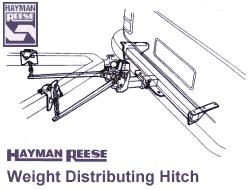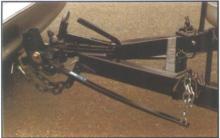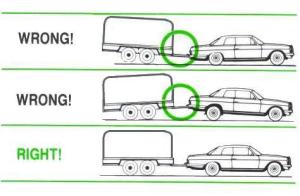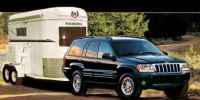|
|
|
|
|
||||||||||||||||
 |
|||||||||||||||||||
 |
COUPLINGS | ||||||||||||||||||
| I There are five main parts involved in a trailer coupling - the towbar, ball mount or tongue and the tow ball are all attached to the vehicle, while the coupling body and trailer draw bar or A frame form the attachment points on the float.
THE TOWBAR The towbar is the framework which is permanently attached to the back of the vehicle. A properly designed, fitted towbar with an adequate weight rating for your specific needs is essential for safe towing. Hayman Reese manufactures tow bars for most popular model vehicles, and these are designed to line up and attach to a solid part of the vehicle - the rear chassis, or other reinforced parts, it the vehicle only has a partial chassis. Cheap tow bars that bolt only the rear bumper or it’s mountings are only suitable for towing very light trailers, and could quite easily break under the load of a horse float. The tow bar should be rated to tow the load you have in mind - for instance, a trailer with two horses plus gear is usually a little under two tonnes. Tow bars manufactured after July 1, 1988 for passenger vehicles are marked with their load capacity and the vehicle model for which they are intended. Do not assume that the tow bar fitted to your vehicle is necessarily suitable for the job that you intend it to do - especially if you bought the vehicle second hand. Chances are that it is a lightweight tow bar suitable only for towing a box trailer. If you tow your horse with a lightweight tow bar, you risk having the tow bar snap, and your horse and other road users will be put in serious jeopardy.
THE BALLMOUNT
THE TOWBALL Towballs suitable for up to 3500 Kg must be 50 mm in diameter and must meet the Australian Standard AS 4177 - 3. To meet this standard the shank needs to me 22.2 mm in diameter and should have 50 and 3500 or 3.5 tonne stamped on it.3. Ask your Hayman Reese dealer for advice. (www.haymanreese.com.au) COUPLING OR HITCH The coupling or hitch is attached to the frame of the float, and provides a socket for the 50 mm towball. It is usually bolted to the float. The coupling, like the towball, must comply with Australian Standards AS 4177 - 2 - 1994 (for 750 kg, 2000 kg or 3500 kg trailer rating classes) The coupling must have a capacity at least equal to the laden weight of your float. SAFETY CHAINS In all states in Australia safety chains are mandatory. For a laden trailer up to 2500 Kg, a chain of at least 10 mm diameter is required. Refer AS 4177 - 4 - 1994. The chains must attach between the A frame, or draw bar of the float to the main towbar framework. This attachment is by D shackles, which should be at least 12.6 mm thick. It is vital that the chains should attach to the main towbar framework and not to the ball mount. Even though all of a heavy duty tow bar should be made to withstand the strain, if there is a failure it is more likely to be in the ball mount that in the towbar body. If the chains were attached to the ball mount, and it should snap or become detached, the chains would be useless. The chains are there for safety, so put them where they can best do their job - on the towbar body. LOAD DISTRIBUTION BARS Sometimes called, Level Riders. These typically consist of a special fitting attached to the ball mount, which allows a pair of springy rods (about 1 meter long) to swing side to side beside the tow hitch. After the float is attached to the vehicle, these bars are held parallel to, and either side of the float’s A frame by short chains. They allow some of the load on the towball to be transferred to the towing vehicle, levelling out the ride and making the vehicle/float combination more stable. Some of these devices will help to eliminate any tendency for the float to "fishtail" or sway. As this equipment is an "add-on" to other equipment, you will need to carefully match the fittings on your float and vehicle’s towbar set up and coupling. Please discuss your requirements with your Hayman Reese dealer as he will be able to recommend the most suitable equipment. Load distribution bars or level riders can greatly improve stability of the float and improve the handling of the vehicle, particularly if the float puts a lot of pressure on the rear of the vehicle. This equipment also provides a smoother ride for the horses on board, so it is worth the investment. Again, talk to your Hayman Reese dealer for best advise.
SWAY CONTROL There are four different designs of sway control available in Australia which can be fitted to floats to resist any initial tendency to sway and also dampen any sway which may occur whilst driving. You should talk to your Hayman Reese dealer. www.haymanreese.com.au A LEVEL & BALANCED CONNECTION When attaching the float to the tow vehicle, it is important that no undue pressure caused by a mis-match of the levels of the fittings or an unbalanced load. The diagram below will clearly outline the ideal level connection.
|
|||||||||||||||||||

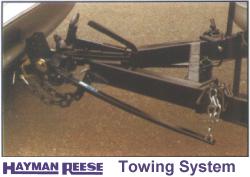


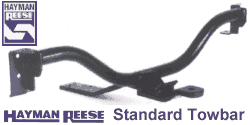
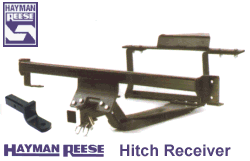
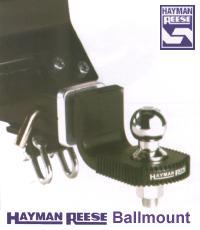 The ballmount is
the part of the tow bar to which the ball is attached. If you have one of the standard
heavy-duty towbar set ups on your vehicle, you will probably have a large square section
of metal that inserts into the towbar, and is held in place with a pin. This type of ball
mount can be remove when not towing, if theft is a concern. Hayman Reese have a lockable
pin as an accessory - which will help deter would be thieves!
The ballmount is
the part of the tow bar to which the ball is attached. If you have one of the standard
heavy-duty towbar set ups on your vehicle, you will probably have a large square section
of metal that inserts into the towbar, and is held in place with a pin. This type of ball
mount can be remove when not towing, if theft is a concern. Hayman Reese have a lockable
pin as an accessory - which will help deter would be thieves!